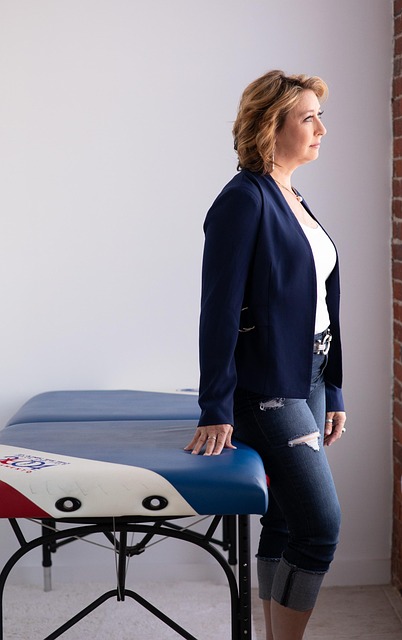Cryolipolysis therapy, or fat freezing, is a non-invasive body contouring treatment that uses cold temperatures to target and destroy specific fat cells, particularly in problem areas like love handles, belly bulges, and muffin tops. This procedure offers minimal downtime, preserves surrounding tissue, and allows patients to resume normal activities immediately. Ideal candidates are healthy individuals committed to post-treatment lifestyle changes. Common temporary side effects include redness, swelling, discomfort, bruising, or numbness, while rare but severe complications may occur. Consulting a qualified healthcare provider before starting is crucial for ensuring eligibility, setting realistic expectations, and minimizing risks.
“Discover the revolutionary body contouring treatment, cryolipolysis therapy, or fat freezing as it’s commonly known. This non-invasive procedure is transforming the way we target stubborn fat cells. By using controlled cold, cryolipolysis selectively freezes and destroys fat, offering a safe and effective alternative for those seeking to sculpt their figure.
This comprehensive guide explores the science behind the treatment, its numerous benefits, candidate eligibility, and what to expect during and after the procedure, along with essential safety precautions.”
- Understanding Cryolipolysis Therapy: How Does It Work?
- Targeting Stubborn Fat Cells: The Science Behind It
- Benefits and Advantages of Fat Freezing Treatment
- Who Is a Good Candidate for Cryolipolysis?
- Procedure Overview: What to Expect During and After
- Potential Side Effects and Safety Precautions
Understanding Cryolipolysis Therapy: How Does It Work?

Cryolipolysis therapy, also known as fat freezing, is a non-invasive procedure that contours the body by targeting and freezing stubborn fat cells. This innovative treatment has gained popularity due to its ability to reduce fat deposits without surgery or downtime. The process involves using controlled cold to break down fat cells, which are then naturally eliminated from the body by the immune system.
During a typical session, a specialized device applies targeted cooling to specific areas of the body. This triggers a natural process in the fat cells, causing them to shrink and eventually die. As these cells are metabolically active and require energy to survive, they are broken down and processed by the liver, where they are converted and removed from the body as waste. The result is a noticeable reduction in fat thickness, leading to a more sculpted and contoured appearance.
Targeting Stubborn Fat Cells: The Science Behind It

Fat freezing, or cryolipolysis therapy, works by targeting and freezing specific fat cells. This non-invasive procedure uses cold temperatures to disrupt the fat cell’s structure, causing them to break down and be naturally eliminated from the body. The science behind it lies in understanding that different types of fat cells are more susceptible to this treatment than others.
Cryolipolysis specifically targets subcutaneous fat, the kind that sits just beneath the skin. It prefers certain areas like love handles, belly bulges, and muffin tops, where a higher proportion of these fat cells reside. The cold temperature doesn’t harm the skin or other tissues, making it a safe option for contouring various body parts.
Benefits and Advantages of Fat Freezing Treatment

Fat freezing, or cryolipolysis therapy, offers a non-invasive and effective way to reduce stubborn fat deposits. One of its key advantages is minimal downtime and recovery compared to surgical procedures. Patients can return to their regular activities almost immediately after the treatment, making it an attractive option for those seeking body contouring without significant changes in their daily routines.
Additionally, cryolipolysis provides precise targeting of fat cells, allowing for a more customized approach. This technology cools the targeted fat to temperatures below zero, freezing and destroying these cells while leaving surrounding tissue unharmed. Over time, the frozen fat cells are naturally eliminated from the body, leading to a slimmer and more defined silhouette without any incisions or extensive recovery periods.
Who Is a Good Candidate for Cryolipolysis?

Cryolipolysis, or fat freezing, is a non-invasive treatment that’s suitable for individuals looking to reduce specific areas of stubborn fat. A good candidate for this therapy is someone with healthy weight and skin, free from medical conditions that could interfere with the procedure or its outcomes. It’s particularly beneficial for people who have tried dieting and exercise without success in targeted fat loss.
Ideal candidates typically have well-defined areas of concern, such as love handles, belly fat, or a bulge above the knees. They should also be committed to maintaining a healthy lifestyle after treatment to ensure optimal results. Before undergoing cryolipolysis therapy, consulting with a qualified healthcare provider is essential to determine eligibility and set realistic expectations.
Procedure Overview: What to Expect During and After

Fat freezing, or cryolipolysis therapy, is a non-invasive procedure designed to target and break down fat cells. During the treatment, a cooling technology applies precise cold to specific areas of the body, selectively destroying the fat cells while leaving surrounding tissue unharmed. This process stimulates your body’s natural metabolism, causing targeted fat cell reduction over time.
After the procedure, it’s common to experience temporary redness or mild discomfort in the treated areas. Most people resume their normal activities shortly after, though some may need a few days to recover fully. Results of cryolipolysis therapy typically become visible within several weeks as the body eliminates the destroyed fat cells. A series of treatments is often recommended for optimal contouring results.
Potential Side Effects and Safety Precautions

While cryolipolysis therapy is generally safe, as with any medical procedure, there are potential side effects to be aware of. Common temporary reactions include redness, swelling, and discomfort at the treatment area. In some cases, patients may experience bruising or numbness, but these usually subside within a few days. More severe but rare complications can occur, such as tissue damage, skin discoloration, or fluid accumulation.
To ensure safety during cryolipolysis treatment, it’s crucial to choose a qualified and experienced provider. They should thoroughly assess your medical history and discuss any concerns before proceeding. Follow-up appointments are also essential to monitor progress and address any adverse reactions promptly. Always adhere to post-treatment care instructions, including staying hydrated and avoiding strenuous activities in the treated area, to minimize risks and maximize results.
